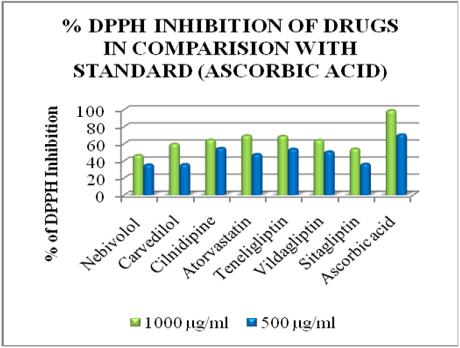
An in vitro study to compare the anti-oxidant properties of cardiovascular and anti-diabetic drugs
Abstract
Introduction: Oxidative stress plays an important role in various pathological conditions like Diabetes mellitus, Hypertension, Malignancies, Alzheimers disease, etc. Scientific evidence suggests that antioxidants reduce the risk of these chronic diseases.2 There are numerous cardiovascular and anti-diabetic drugs available which have additional antioxidant properties. The aim of this study is to comparatively evaluate the antioxidant properties of cardiovascular drugs like Nebivolol, Carvedilol, Cilnidipine, Atorvastatin and that of anti-diabetic drugs like Sitagliptin, Vildagliptin and Tenegliptin by their free radical scavenging property using DPPH (2,2-diphenyl 1-picryl hydrazyl hydrate) assay. Methodology: Oral formulations of Nebivolol, Carvedilol, Cilnidipine, Atorvastatin, Sitagliptin, Vildagliptin, Teneligliptin were crushed separately into fine powders and stock solutions of 1000 and 500 μg/ml were prepared using ethanol. Ascorbic acid was used as the reference antioxidant. The percentage of antioxidant activity was assessed by DPPH assay method described by Brand Williams et al. Results: At concentrations of 1000 μg/ml and 500 μg/ml, the percentage of DPPH inhibition by the drugs were: Nebivolol - 46.38% and 35.28%, Carvedilol - 59.58% and 35.74%, Cilnidipine - 64.37% and 54.67%, Atorvastatin - 69.39% and 47.55%, Teneligliptin - 68.81% and 53.74%, Vildagliptin - 63.90% and 50.58% and Sitagliptin - 53.86% and 36.21% respectively. The percentage of DPPH inhibition for the same concentration of Ascorbic acid was 98.83% and 70.44% respectively. Conclusion: Our study has demonstrated the in vitro anti-oxidant activity of the commonly used cardiovascular drugs (Nebivolol, Carvedilol, Cilnidipine and Atorvastatin) and antidiabetic drugs (Teneligliptin, Vildagliptin and
Sitagliptin) which could have a therapeutic advantage of preventing oxidative stress induced complications in patients who are on long term treatment for cardiovascular diseases and diabetes mellitus.
Full Text:
PDFReferences
Hussain T, Tan B, Yin Y, Blachier F, Tossou MC, Rahu N. Oxidative stress and inflammation: what polyphenols can do for us?. Oxidative medicine and cellular longevity. 2016 Sep 22;2016.
Tailor CS, Goyal A. Antioxidant activity by DPPH radical scavenging method of Ageratum conyzoides Linn. leaves.
Sies H. Oxidative stress: oxidants and antioxidants. Experimental physiology. 1997 Mar 1;82(2):291-5.
Gupta D. Methods for determination of antioxidant capacity: a review. International Journal of Pharmaceutical Sciences and Research. 2015 Feb 1;6(2):546.
Dikalov SI, Dikalova AE. Contribution of mitochondrial oxidative stress to hypertension. Current opinion in nephrology and hypertension. 2016 Mar 1;25(2):73-80.
Steven S, Münzel T, Daiber A. Exploiting the pleiotropic antioxidant effects of established drugs in cardiovascular disease. International journal of molecular sciences. 2015 Aug 5;16(8):18185-223.
Karabacak M, Dogan A, Tayyar S, Bas HA. The effects of carvedilol and nebivolol on oxidative stress status in patients with non-ischaemic heart failure. Kardiologiapolska. 2015 Jan 1;73(3):201-6.
Zepeda RJ, Castillo R, Rodrigo R, Prieto JC, Aramburu I, Brugere S, Galdames K, Noriega V, Miranda HF. Effect of carvedilol and nebivolol on oxidative stress‐related parameters and endothelial function in patients with essential hypertension. Basic & clinical pharmacology & toxicology. 2012 Nov 1;111(5):309-16.
Lee YJ, Park KH, Park HH, Kim YJ, Lee KY, Kim SH, Koh SH. Cilnidipine mediates a neuroprotective effect by scavenging free radicals and activating the phosphatidylinositol 3‐kinase pathway. Journal of neurochemistry. 2009 Oct 1;111(1):90-100.
Hishikawa K, Takase O, Idei M, Fujito T. Comparison of antioxidant activity of cilnidipine and amlodipine. Kidney international. 2009 Jul 2;76(2):230-1.
Soeki T, Kitani M, Kusunose K, Yagi S, Taketani Y, Koshiba K, Wakatsuki T, Orino S, Kawano K, Sata M. Renoprotective and antioxidant effects of cilnidipine in hypertensive patients. Hypertension Research. 2012 Nov 1;35(11):1058-62.
Ma Y, Chen Z, Zou Y, Ge J. Atorvastatin represses the angiotensin 2-induced oxidative stress and inflammatory response in dendritic cells via the PI3K/Akt/Nrf 2 pathway. Oxidative medicine and cellular longevity. 2014 Jul 3;2014.
Zhang L, Cheng L, Wang Q, Zhou D, Wu Z, Shen L, Zhang L, Zhu J. Atorvastatin protects cardiomyocytes from oxidative stress by inhibiting LOX-1 expression and cardiomyocyte apoptosis. ActabiochimicaetbiophysicaSinica. 2015 Mar 1;47(3):174-82.
Koksal M, Eren MA, Turan MN, Sabuncu T. The effects of atorvastatin and rosuvastatin on oxidative stress in diabetic patients. European journal of internal medicine. 2011 Jun 30;22(3):249-53.
Pujadas G, De Nigris V, Prattichizzo F, La Sala L, Testa R, Ceriello A. The dipeptidyl peptidase-4 (DPP-4) inhibitor teneligliptin functions as antioxidant on human endothelial cells exposed to chronic hyperglycemia and metabolic high-glucose memory. Endocrine. 2016 Aug 16:1-2.
Baggio LL, Drucker DJ. Biology of incretins: GLP-1 and GIP. Gastroenterology. 2007 May 31;132(6):2131-57.
Papagianni M, Tziomalos K. Cardiovascular effects of dipeptidyl peptidase-4 inhibitors. Hippokratia. 2015 Jul;19 (3):195.
Cijoy Jose P, Vasanthi C, David DC, Stephen A. Evaluation of antioxidant property of vildagliptin. 19. Ravi A, Muthiah NS, Elizabeth AA, Muniappan, Philip S, et al. Evaluation of radical scavenging property of Sitagliptin. Journal of chemical and pharmaceutical research. 2015 Jul;7(10):273-275.
Shalaby EA, Shanab SM. Antioxidant compounds, assays of determination and mode of action. African journal of pharmacy and pharmacology. 2013 Mar 15;7(10):528-39.
Brand-Williams W, Cuvelier ME, Berset CL. Use of a free radical method to evaluate antioxidant activity. LWT-Food science and Technology. 1995 Jan 1;28(1):25-30.
Garcia EJ, Oldoni TL, Alencar SM, Reis A, Loguercio AD, Grande RH. Antioxidant activity by DPPH assay of potential solutions to be applied on bleached teeth. Brazilian dental journal. 2012;23(1):22-7.
Refbacks
- There are currently no refbacks.

This work is licensed under a Creative Commons Attribution-NoDerivatives 4.0 International License.
An initiative of The Tamil Nadu Dr M.G.R. Medical University